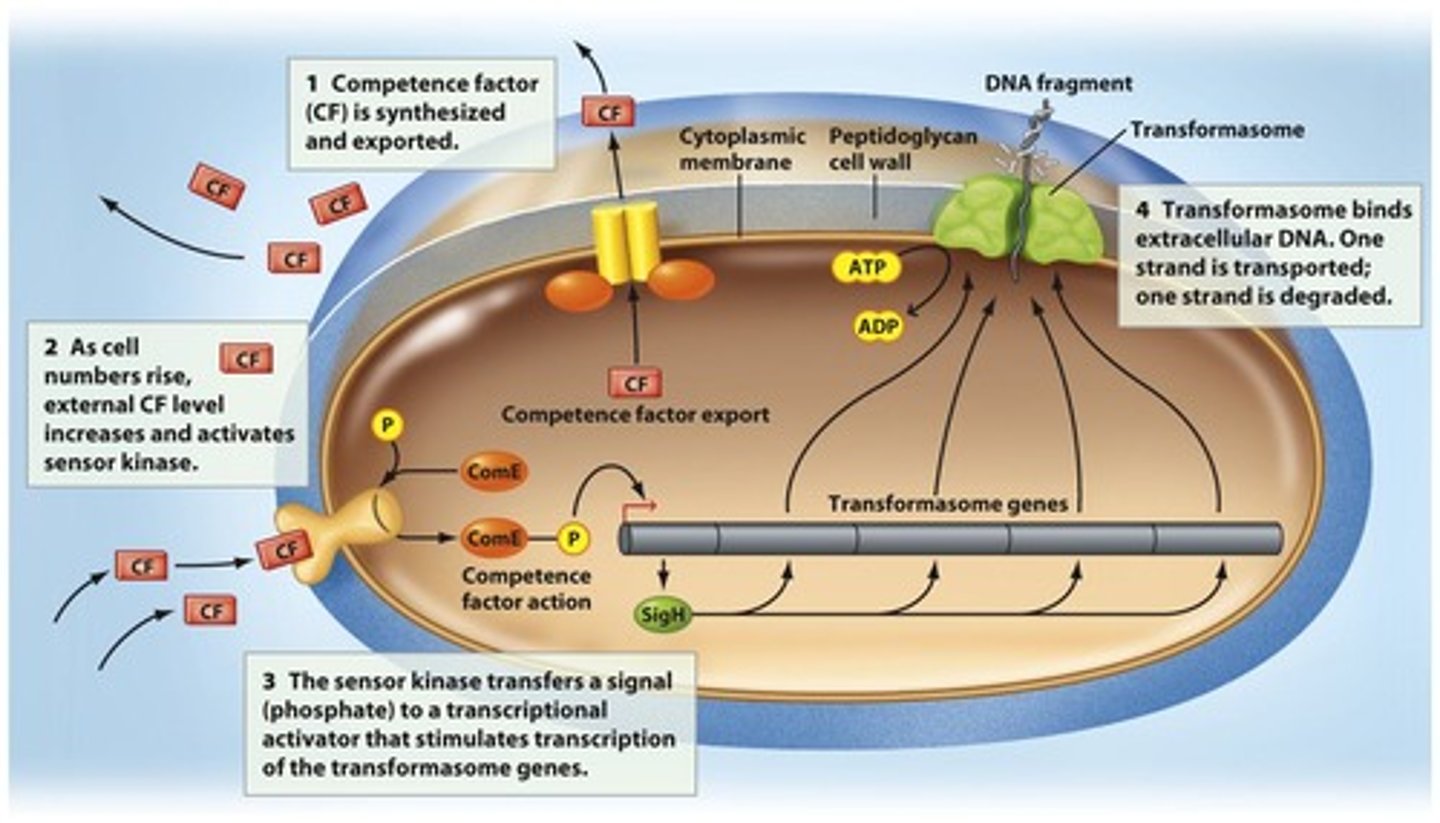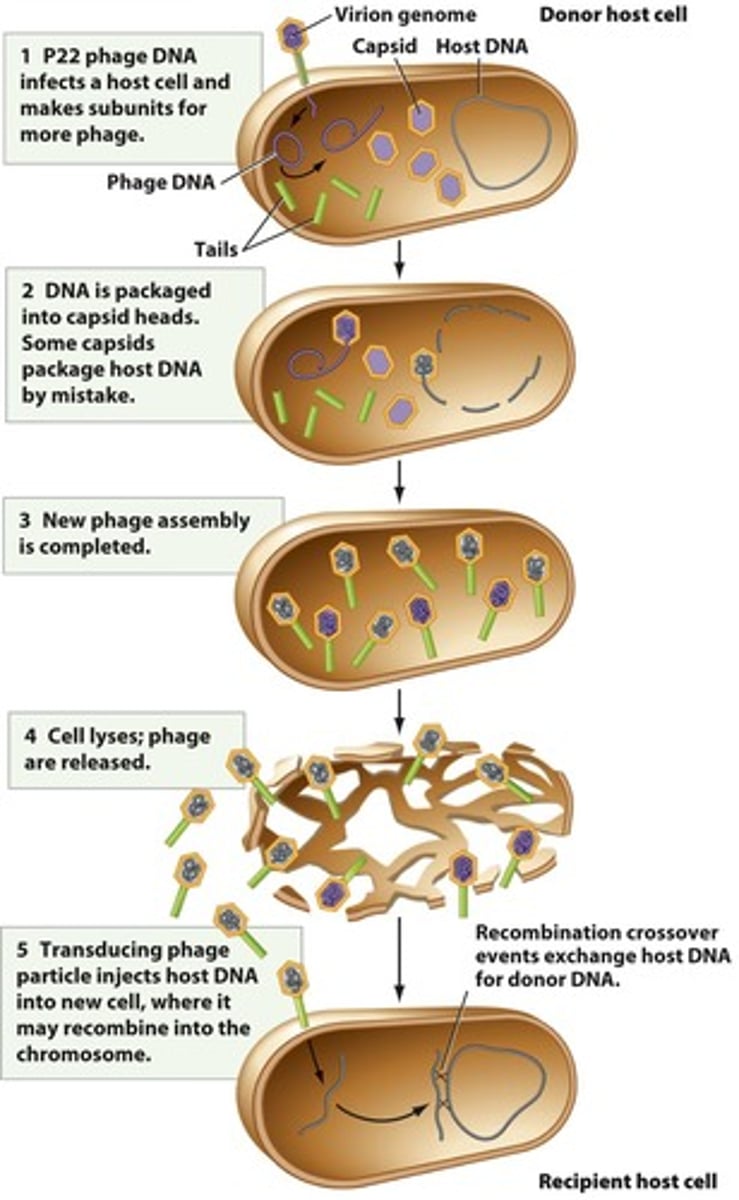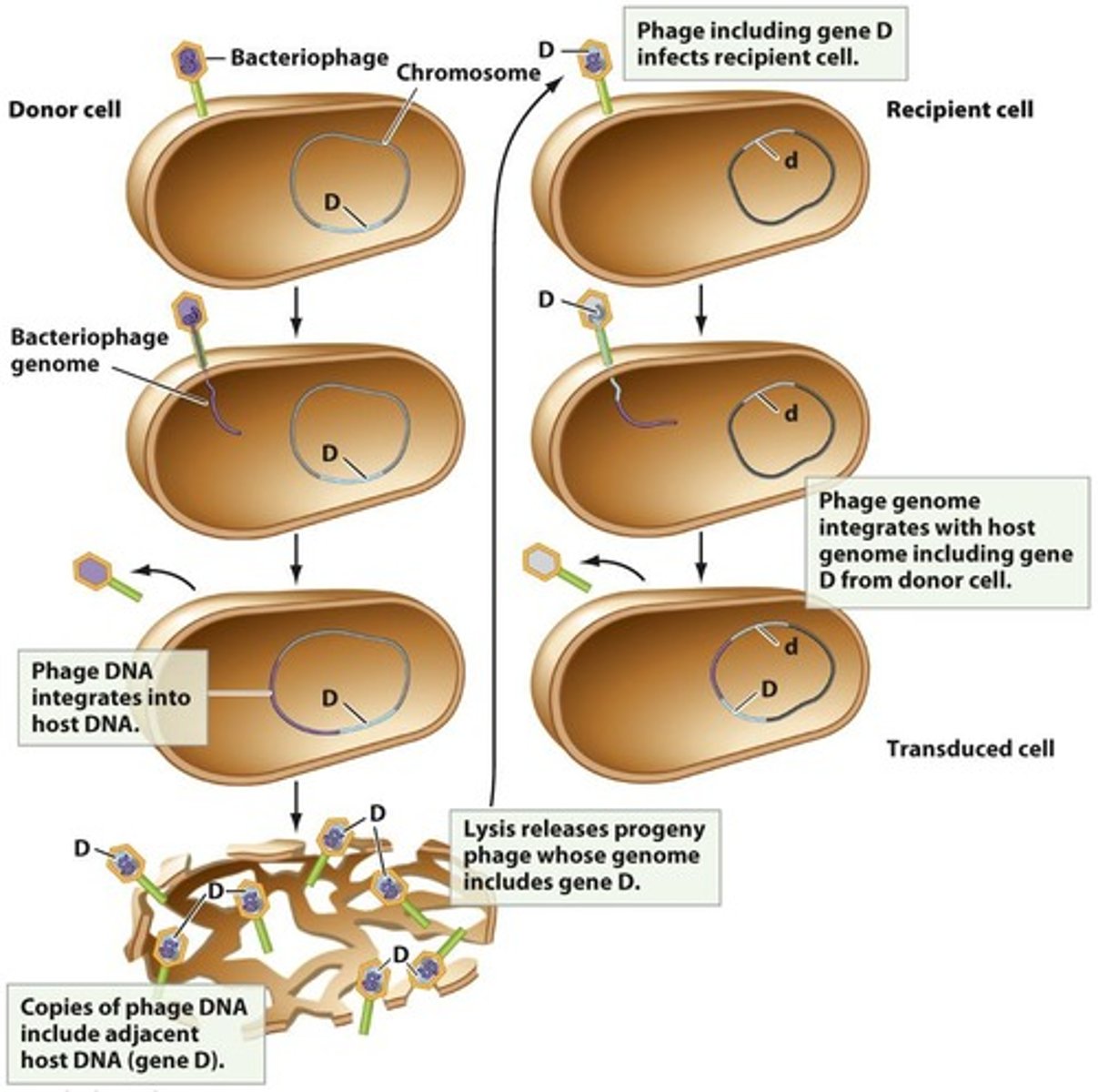Bacterial Genomes and Evolution Concepts
1/62
There's no tags or description
Looks like no tags are added yet.
Name | Mastery | Learn | Test | Matching | Spaced |
|---|
No study sessions yet.
63 Terms
Evolution (to bacteria)
Genetic change (altered genotype) leading to a change in observable traits (altered phenotype), new ability, or different appearance, resulting in a fitness advantage in a given environment.
Microbial taxonomy
Names and identifies organisms based on genomic information that predicts traits of related organisms.
Bacterial genetic exchange
The process by which bacteria share genetic material without sexual reproduction, forming 'clonal' populations.
Horizontal gene transfer
Moving DNA from one bacterium to another through transformation, conjugation, or transduction.
Transformation
Taking up free DNA from the environment into bacterial cells, a property inherent to many bacterial species.

Conjugation
A method of DNA transfer that requires intimate cell contact, typically initiated by a sex pilus from the donor cell.
Transduction
Virus-mediated transfer of DNA from one bacterium to another, involving bacteriophages that can package host DNA.

Generalized recombination
An enzyme-mediated process where two DNA molecules exchange portions, requiring long stretches of sequence similarity.
Homologs / homologous
Genes that are similar, having similar DNA coding sequences, similar protein products, and similar functions.
Paralogs
Similar genes in the same organism that encode for two different proteins with different functions.
Orthologs
Similar genes in different organisms that encode for proteins with the same function.
Natural transformation
A property inherent to many bacterial species that allows them to take up free DNA from the environment.
Artificially competent
Bacteria that have been manipulated to take up free DNA from the environment.
Bacteriophages
Bacterial viruses that can move DNA from one bacterium to another, composed of nucleic acid and a capsid.
Specialized transduction
A process where a virus genome becomes part of the bacterial chromosome.

Mobile genetic elements
Genetic elements that can move around within the genome and facilitate genetic exchange.
Clonal populations
Populations of bacteria that arise from a single ancestor, lacking sexual reproduction.
Fitness advantage
An increased likelihood of survival and reproduction due to advantageous traits in a given environment.
Accidental DNA transfer
The process by which a phage accidentally packages a small piece of host DNA during transduction.
Capsid
The protein shell of a virus that encases its nucleic acid.
Lysing
The process of breaking down a cell, often used to release newly assembled phage particles.
Site specific recombination
Requires very little sequence homology but does require a short sequence recognized by a special recombination enzyme.
Recombination advantages to microbes
Use their own DNA to fix mutations or restart stalled replication forks, repair damaged chromosomes using DNA donated by others of the same species, and obtain genes from other organisms that might enhance the competitive fitness of the cell.
Recombination
DNA molecules are cleaved and reattached to other DNA (chromosome to chromosome or plasmid to chromosome).
Origins and Evolution
All life originated from microbes, and species continue to evolve through changes to genomes.
Genomes change
Via processes of random mutation and natural selection.
Common ancestor
All three domains of life (Archaea, Bacteria, Eukarya) originated from a common ancestor but branched apart and developed unique characteristics.

Genetic relatedness
Arises from common ancestry.
Divergence
As organisms reproduce over many generations, their offspring acquire mutations, leading to divergence.
Family tree of organisms
The gradual divergence of organisms generates a 'family tree' of related organisms, known as phylogeny.
Sources of divergence
Besides mutation, another source of divergence is gene mobility.
Instant speciation
Gain or loss of a large number of genes can lead to a more sudden change.
Natural selection
Favors the organism that produces more offspring in that environment (competitive advantage).
Selective pressure
Genes encoding traits that influence the survival of offspring are said to be under 'selective pressure'.
Reductive evolution
A trait no longer needed for growth or survival is no longer under selective pressure.
Three domains of life
Three major groups called Domains: Bacteria, Archaea, and Eukarya.
Eukaryotes
Possess many complex membranous organelles.
Bacteria
Have a distinctive gene expression apparatus and all bacterial cell walls are made of peptidoglycan.
Archaea
Have distinctive ether-linked membrane lipids and no known Archaea are human pathogens.
Endosymbiotic theory
A free living Bacterium was engulfed by a larger Archaeon, leading to the formation of mitochondrion and eventually Eukaryotes.
Fitness
Depends on environment and is determined by the traits that influence survival and reproduction.
Endosymbiosis
A mutualistic relationship between the host and the symbiont where each is required for normal growth and development.
Degenerative evolution
Loss of traits in the absence of selection pressure.
Microbial species
Defined by the principle that members of different species do not normally interbreed with each other.
Asexual reproduction in bacteria and archaea
Occurs through binary fission, making interbreeding not a basis for classification.
70% DNA hybridization
A metric used to define microbial species based on genetic similarity.
97% similarity of 16S rRNA gene
A threshold used to classify microbial species.
95% identity in ortholog sequence
Another metric for defining microbial species.
Phylogeny
Classification based on DNA relatedness.
Ecology
Classification based on shared traits and ecological niche.
Taxonomy
Description of distinct life forms and their organization into different categories.
Identification
The process of determining the identity of a microbe.
Classification
The arrangement of organisms into categories.
Nomenclature
The system of naming organisms.
Genome sequencing
The most conclusive way to identify a microbe.
DNA-based methods
Preferred methods in clinical practice for identifying microbes.
Dichotomous key
A series of yes/no decisions that narrow down possible categories of species.
Probabilistic indicator
An alternative means of identification that uses biochemical tests and a predefined database.
Bacterial Diversity
Millions of species with thousands isolated and characterized.
Major groups of bacteria
Include Gram-positive, Gram-negative, Spirochetes, Cyanobacteria, Deep Branching, and Chlamydia.
Environmental effects on diversity
Genes are sampled from thousands of species, influencing the evolution of pathogens.
Genetic changes
Occur and are maintained when the change is neutral or beneficial.
Geographic separation
Leads to the development of new species over time.